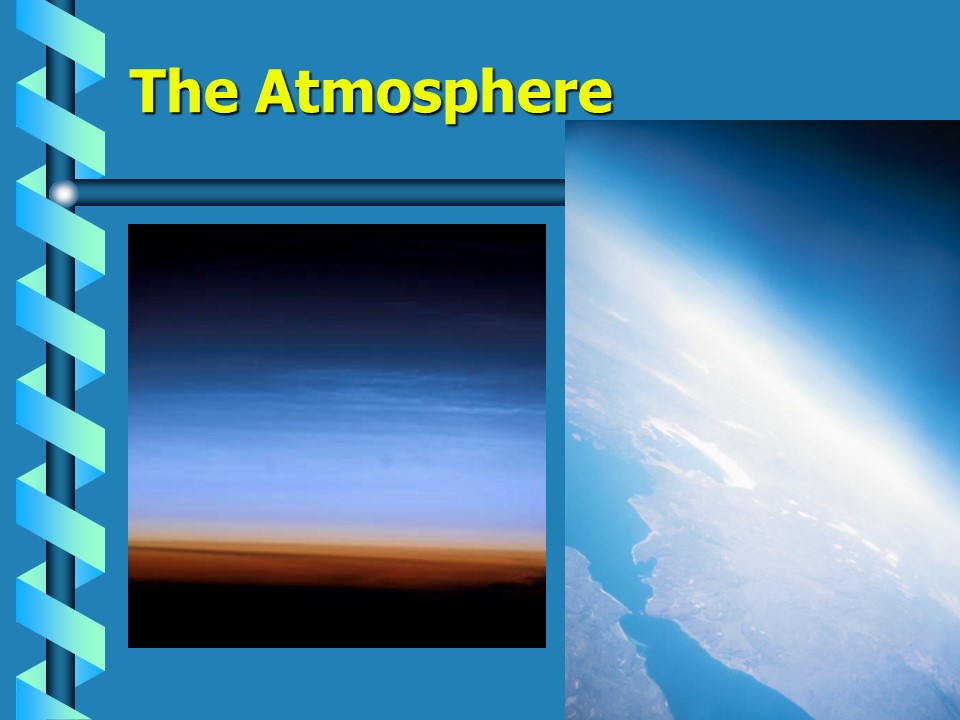The Atmosphere - PowerPoint PPT Presentation
Title: The Atmosphere
1
The Atmosphere
2
BIG Idea
- The composition, structure, and properties of
Earths atmosphere form the basis of Earths
weather and climate.
3
Who studies atmospheric conditions?
- Meteorologiststhats who!
4
- How would you describe the difference between
WEATHER and CLIMATE?
5
(No Transcript)
6
(No Transcript)
7
I. Characteristics of the Atmosphere
- Weather day-to-day changes in atmospheric
conditions. - These conditions include
- Temperature
- Air movements
- Moisture content
8
- Climate general weather conditions averaged
over many (about 30) years
9
A. Composition of the Atmosphere
- 78 Nitrogen
- 21 Oxygen
- 0.9 Argon
- 0.1 Other
10
- Ozone protects us
- from harmful UV (ultraviolet)
rays - Damaged by CFCs
- (poisons in ACs
- and refrigerators)
Ozzy Ozone
11
- Have you noticed the weather today?
- How would you describe it?
12
B. Properties of the Atmosphere
- Temperature
- Air Pressure
- Humidity
13
1. Temperature
- measure of the average kinetic
energy of particles in a material - more energy moving faster higher temperature
- measured with a thermometer
14
2. Atmospheric (Air) Pressure
- the ratio of the force of the air to the area of
the surface on which it presses - the weight of the atmosphere pressing down on
Earths surface
15
BAROMETER
- an instrument that measures atmospheric pressure
16
a. Mercurial Barometer
17
b. Aneroid Barometer
- Aneroid without liquid
18
3. Humidity
- the amount of water vapor in the atmosphere at a
given location on Earths surface
19
C. Layers of the Atmosphere
- Based on temperature differences, scientists
identify four layers of Earths atmosphere - Each layer is separated by a pause
20
- Visualizing the Layers of the Atmosphere
21
(No Transcript)
22
(No Transcript)
23
1. Troposphere all weather occurs here
- Layer closest to Earths surface
24
2. Stratosphere where most of the ozone is
25
3. Mesosphere coldest layer (-90C )4.
Thermosphere hottest layer (over 2000C)
nitrogen and oxygen atoms absorb solar energy
26
(No Transcript)
27
- Components of the Atmosphere - Quiz
28
II. Solar Energy
- A. Radiation all forms of energy that travel
through space as waves
29
(No Transcript)
30
What happens to solar energy that reaches Earths
surface?
31
- reflected (sent in a new direction), or
- absorbed
32
(No Transcript)
33
- Why does the inside of a closed parked car heat
up, while the windows stay cool?
34
(No Transcript)
35
(No Transcript)
36
B. Greenhouse Effect atmosphere traps (long)
infrared rays
- The Suns energy
- is trapped inside.
37
(No Transcript)
38
- What are the greenhouse gases that trap heat
within our atmosphere?
39
- Water vapor
- Carbon dioxide
- produced by humans
- burning of fossil fuels (oil, gas, coal)
40
(No Transcript)
41
(No Transcript)
42
C. Heat Energy Transfer
43
(No Transcript)
44
- Convection transfer of heat energy in gases or
liquids due to density differences.
45
- 2. Conduction transfer of heat energy through
matter from particle to particle
most effective in
solids.
46
- 3. Radiation waves that directly transport
energy through space brings
HEAT to our planet.
47
III. Winds
- Created by uneven heat distribution at Earths
surface - The amount of energy reaching any given point on
Earths surface is controlled by the angle of
sunlight striking the surface
48
- What causes the amount of energy to vary?
- Hint
49
(No Transcript)
50
- Our tilt, and the seasons!
- Where on Earth will you receive more of the suns
energy per unit area? - Where will you receive less?
51
(No Transcript)
52
(No Transcript)
53
(No Transcript)
54
- The Coriolis Effect Earths rotation causes
winds to deflect (curve) to the right in the
Northern Hemisphere and to the left in the
Southern Hemisphere. - Same with water
55
(No Transcript)
56
A. Global Winds
- Winds are named according to the direction FROM
which they flow! - 1. Trade Winds winds in both hemispheres
flowing towards the equator - between 30 (N and S) and 0 latitude
57
- Doldrums weak and unpredictable air mix, 5 N
and S of the equator - winds CONVERGE here to form an area of LOW
pressure - b. Horse Latitudes very weak air movement 30-
35 N and S
58
- 2. Westerlies between 30 and 60 N and S.
- 3. Polar Easterlies weak winds at 60 N and S
that flow away from the poles.
59
(No Transcript)
60
TICKET ITEM!!
- Why does warm air rise from the equator, and cold
air sink at the poles?
61
62
- 4. Jet Stream bands of high- speed
high-altitude westerly winds.
63
B. Local Winds / Breezes
64
1. Sea Breeze in the daytime, winds from cooler
water replace warm rising land air
65
2. Land Breeze at night, winds from cooler land
replace warm air over the water
66
3. Valley Breeze in the day warm air rises UP
the valley
67
4. Mountain Breeze at night, cool air sinks
DOWN the mountain
68
What causes weather?
- uneven heating by the Sun due to Earths axis
tilt - energy transfer between Earths surface and the
atmosphere































